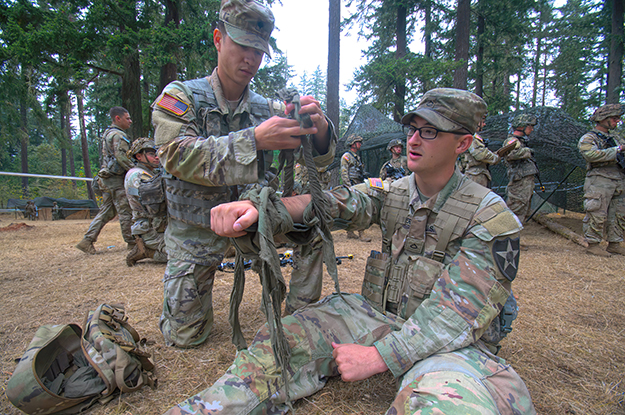SPC Mohamed Abdelaziz was not far from a station where soldiers trained to evaluate and treat a casualty for a spinal injury and shock. Sitting cross-legged and writing with an old-fashion wood pencil, he was a study in concentration.
"I'm am going over and committing to memory the 12 identifying signs and symptoms of shock that accompany a spinal injury," commented the 1-2 Stryker Brigade Combat Team (SBCT), 7th Infantry Division soldier assigned to 5th Battalion, 20th Infantry Regiment.
Abdelaziz was one of about 800 soldiers training in order to earn either an expert Infantryman Badge (EIB), an Expert Field Medical Badge (EFMB), or an Expert Soldier Badge (EIB). 1-2 SBCT hosted the training and testing events.
"I'm a vehicle mechanic, but this training broadens my knowledge and makes me better trained and complete soldier. I hope to earn my EIB."
What Abdelaziz and the other soldiers engaged in the training is indicative of the Army's attempt to align the three badges into what is now referred to a E3B.
At an E3B conference hosted by the U.S. Army Medical Center of Excellence (MEDCoE) at Joint Base San Antonio-Fort Sam Houston this past February, subject matter experts met to discuss and improve the alignment of the three badges.
"Aligning the three badges is expected to consolidate resources and personnel requirements for combined events, resulting in cost reductions for hosting units and reduced personnel requirements," said Capt. Alyssa Schlegel of the MEDCoE's EFMB test control office.
She added that the realignment will allow for increased testing opportunities, and units that regularly execute EIB and ESB can easily add EFMG into the concept.
"This medical lane for fractures and burns is challenging but good to know," commented SPC Alejandro Ramos as he unrolled a bandage in preparation to place a splint on PFC Andrew Joyner's broken right arm.
Mortarmen assigned to 2nd Battalion, 3rd Infantry Regiment, 1-2 SBCT, Ramos and Joyner were training to earn their EIB.
"This medical training is good to know if we need to do something like this."
Once they have sharpened their skills, they test for the badge. Only 25 to 30 percent will earn one of the three badges. To earn any one of the three coveted badges, soldiers face a multitude of tasks that must be completed in a limited amount of time.
"For example, there are a number of weapons lanes that they must be proficient in," said 1st SGT Bonifacio Castro, 1st Battalion, 23rd Infantry Regiment, 1-2 SBCT.
He added that candidates will be tested on the M249 & M240 machine guns, the M17 pistol, the M500 series shotgun, the Claymore anti-personnel weapon, the M320 Grenade Launcher, the Mark 19 grenade launcher, the .50 caliber machine gun, the Javelin anti-tank weapon, and grenades.
"As these soldiers learn more about what other soldiers do and gain a broader knowledge of what they do, it is hoped that they pass on what they have learned here to other soldiers," concluded Castro.





Read Comments